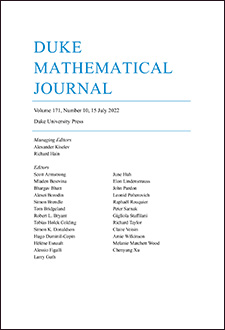Abstract
The cohomology $H ^* (\Gamma, E)$ of an arithmetic subgroup $\Gamma$ of a connected reductive algebraic group $G$ defined over some algebraic number field $F$ can be interpreted in terms of the automorphic spectrum of $\Gamma$. With this framework in place, there is a sum decomposition of the cohomology into the cuspidal cohomology (i.e., classes represented by cuspidal automorphic forms for $G$) and the so-called Eisenstein cohomology constructed as the span of appropriate residues or derivatives of Eisenstein series attached to cuspidal automorphic forms on the Levi components of proper parabolic $F$-subgroups of $G$. The main objective of this paper is to isolate a specific structural part in the Eisenstein cohomology. This pertains to regular Eisenstein cohomology classes attached to cuspidal automorphic representations whose archimedean component is tempered. It is shown that the cohomological degree of these classes is bounded from below by the constant $q_0(G(\mathbb{R}))=((1/2) [\dim X_{G(\mathbb{R})}-(\rk (G(\mathbb{R}))-\rk(K_{\mathbb{R}}))]$, where $K_{\mathbb{R}}$ denotes a maximal compact subgroup of the real Lie group $G(\mathbb{R})$, where $X_{G(\mathbb{R})}$ is the associated symmetric space. This investigation has various applications. One of these is a vanishing result for the cohomology in the generic case (i.e., where the representation determining the coefficient system $E$ has regular highest weight) in degrees below $q_0(G(\mathbb{R}))$. This is a sharp bound depending only on the underlying real Lie group $G(\mathbb{R})$ (Corollary 5.6, Proposition 5.8). This result is supplemented by a qualitative structural result in the description of the cohomology in higher degrees by means of regular Eisenstein cohomology classes.
Citation
Jian-Shu Li. Joachim Schwermer. "On the Eisenstein cohomology of arithmetic groups." Duke Math. J. 123 (1) 141 - 169, 15 May 2004. https://doi.org/10.1215/S0012-7094-04-12315-2
Information





